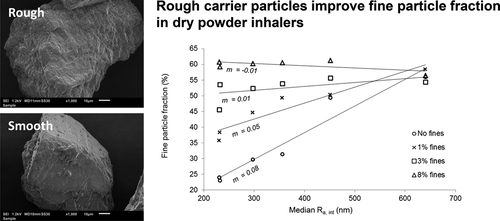当前位置:
X-MOL 学术
›
Mol. Pharmaceutics
›
论文详情
Our official English website, www.x-mol.net, welcomes your
feedback! (Note: you will need to create a separate account there.)
Characterizing the Surface Roughness Length Scales of Lactose Carrier Particles in Dry Powder Inhalers
Molecular Pharmaceutics ( IF 4.5 ) Pub Date : 2018-02-28 00:00:00 , DOI: 10.1021/acs.molpharmaceut.8b00007 Bernice Mei Jin Tan 1 , Lai Wah Chan 1 , Paul Wan Sia Heng 1
Molecular Pharmaceutics ( IF 4.5 ) Pub Date : 2018-02-28 00:00:00 , DOI: 10.1021/acs.molpharmaceut.8b00007 Bernice Mei Jin Tan 1 , Lai Wah Chan 1 , Paul Wan Sia Heng 1
Affiliation

|
Surface roughness is well recognized as a critical physical property of particulate systems, particularly in relation to adhesion, friction, and flow. An example is the surface property of carrier particles in carrier-based dry powder inhaler (DPI) formulations. The numerical characterization of roughness remains rather unsatisfactory due to the lack of spatial (or length scale) information about surface features when a common amplitude parameter such as average roughness (Ra) is used. An analysis of the roughness of lactose carrier particles at three different length scales, designed for specificity to the study of interactive mixtures in DPI, was explored in this study. Three Ra parameters were used to represent the microscale, intermediate scale, and macroscale roughness of six types of surface-modified carriers. Coating of micronized lactose fines on coarse carrier particles increased their microroughness from 389 to 639 nm while the macroroughness was not affected. Roller compaction at higher roll forces led to very effective surface roughening, particularly at longer length scales. Changes in Ra parameters corroborated the visual observations of particles under the scanning electron microscope. Roughness at the intermediate scale showed the best correlation with the fine particle fraction (FPF) of DPI formulations. From the range of 250 to 650 nm, every 100 nm increase in the intermediate roughness led to ∼8% increase in the FPF. However, the effect of surface roughness was greatly diminished when fine lactose (median size, 9 μm) of comparable amounts to the micronized drug were added to the formulation. The combination of roughness parameters at various length scales provided much discriminatory surface information, which then revealed the “quality” of roughness necessary for improving DPI performance.
中文翻译:

表征干粉吸入器中乳糖载体颗粒的表面粗糙度长度尺度
表面粗糙度被公认为颗粒系统的关键物理性能,特别是在附着力,摩擦和流动方面。一个例子是基于载体的干粉吸入器(DPI)制剂中载体颗粒的表面性质。当使用诸如平均粗糙度(R a)之类的共同幅度参数时,由于缺乏有关表面特征的空间(或长度尺度)信息,粗糙度的数值表征仍然不能令人满意。在这项研究中,探讨了针对三种不同长度尺度的乳糖载体颗粒粗糙度的分析方法,旨在研究DPI中相互作用混合物的特异性。三个R a参数用于代表六种类型的表面改性载体的微观,中间尺度和宏观尺度粗糙度。在粗载体颗粒上涂覆微粉化的乳糖细粉后,其微粗糙度从389 nm增加到639 nm,而宏观粗糙度没有受到影响。在较高的轧制力下进行轧制压实会导致非常有效的表面粗糙化,尤其是在较长的长度范围内。R a的变化参数证实了在扫描电子显微镜下对颗粒的视觉观察。中等规模的粗糙度显示出与DPI配方的细颗粒分数(FPF)的最佳相关性。从250到650 nm的范围,中间粗糙度每增加100 nm,导致FPF约增加8%。但是,当将与微粉化药物相当量的细乳糖(中值粒径,9μm)添加到制剂中时,表面粗糙度的影响将大大降低。各种长度尺度下的粗糙度参数的组合提供了许多可区分的表面信息,这些信息随后揭示了改善DPI性能所必需的粗糙度“质量”。
更新日期:2018-02-28
中文翻译:

表征干粉吸入器中乳糖载体颗粒的表面粗糙度长度尺度
表面粗糙度被公认为颗粒系统的关键物理性能,特别是在附着力,摩擦和流动方面。一个例子是基于载体的干粉吸入器(DPI)制剂中载体颗粒的表面性质。当使用诸如平均粗糙度(R a)之类的共同幅度参数时,由于缺乏有关表面特征的空间(或长度尺度)信息,粗糙度的数值表征仍然不能令人满意。在这项研究中,探讨了针对三种不同长度尺度的乳糖载体颗粒粗糙度的分析方法,旨在研究DPI中相互作用混合物的特异性。三个R a参数用于代表六种类型的表面改性载体的微观,中间尺度和宏观尺度粗糙度。在粗载体颗粒上涂覆微粉化的乳糖细粉后,其微粗糙度从389 nm增加到639 nm,而宏观粗糙度没有受到影响。在较高的轧制力下进行轧制压实会导致非常有效的表面粗糙化,尤其是在较长的长度范围内。R a的变化参数证实了在扫描电子显微镜下对颗粒的视觉观察。中等规模的粗糙度显示出与DPI配方的细颗粒分数(FPF)的最佳相关性。从250到650 nm的范围,中间粗糙度每增加100 nm,导致FPF约增加8%。但是,当将与微粉化药物相当量的细乳糖(中值粒径,9μm)添加到制剂中时,表面粗糙度的影响将大大降低。各种长度尺度下的粗糙度参数的组合提供了许多可区分的表面信息,这些信息随后揭示了改善DPI性能所必需的粗糙度“质量”。










































 京公网安备 11010802027423号
京公网安备 11010802027423号